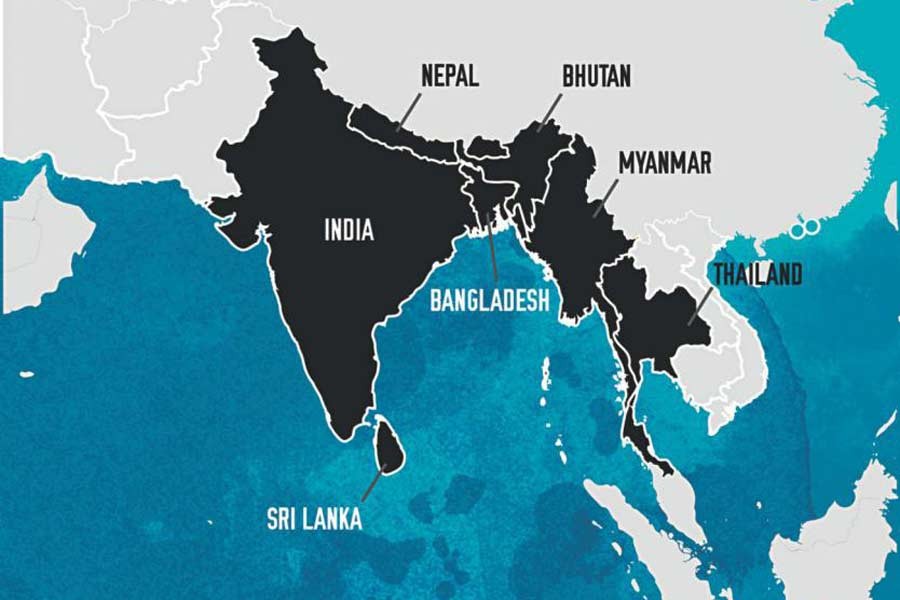
Published :
Updated :

BIMSTEC should pursue not only signing an FTA, but also interconnected agreements - including trade facilitation and cross-border connectivity.
The Bay of Bengal Initiative for Multi-Sectoral Technical and Economic Cooperation (BIMSTEC) has passed 23 years since its inception in 1997. Being a regional cooperation initiative, BIMSTEC promotes co-operation on seven key economic areas including trade, investment, and transport and communications. In this connection, member countries are currently negotiating for establishing the BIMSTEC Free Trade Area to propel trade and investment among member countries. A draft agreement on regional transport connectivity has been finalised.
It is to be noted that traditionally, for their trade and investment, BIMSTEC countries have been linked with only a few fellow BIMSTEC members as they are mostly linked with non-member countries in these areas. Against this backdrop, a 'business as usual' nature of trade co-operation between member countries under a Free Trade Agreement (FTA) would not provide much benefit to BIMSTEC member countries.
BILATERAL TRADE BETWEEN BIMSTEC COUNTRIES: In the current structure of bilateral trade among these countries, we see that most of the BIMSTEC members have experienced a considerable rise in bilateral trade over the years. A larger volume of exports was observed in the case of Thailand's exports to India (US$ 5.5 billion in 2015); India's exports to Sri Lanka (US$ 4.4 billion), Bangladesh (US$ 3.4 billion), and Nepal (US$ 2.6 billion); and Myanmar's exports to Thailand (US$ 3.3 billion) and India (US$ 1.3 billion). Overall, India and Thailand are two major economies - both in terms of export and import - while Bangladesh, Sri Lanka, and Myanmar are three major economies in terms of import.
The bilateral trade record of BIMSTEC countries indicates that the existing pattern of trade is heavily influenced by geographical proximity, relative size of the economies, and predominant trade routes. Based on these factors, three different patterns of bilateral trade are observed between BIMSTEC countries which include: trade between larger member economies, trade with land-locked member economies, and trade with non-member countries under different trade agreements. Overall, the variation in trade between BIMSTEC member countries is overwhelmingly influenced by trade route, logistic facilities, and time and cost to trade.
The pattern of bilateral trade reveals that member states use more than one country as sources for their major exports. For example, Thailand has been used as a major source of import for Myanmar and India with regard to import of organic chemicals, plastic and plastic products, and rubber products. Similarly, Thailand is a major source of import for Bangladesh with regard to plastic products, manmade stable fibres, and manmade filaments. These products are also imported by India and Myanmar from Thailand. In most cases, countries are either sources of raw materials, intermediate products and capital machineries or they are used as destinations for exporting finished products. In other words, the existing structure of bilateral trade shows limited potential to develop strong regional value chains.
In contrast, an overwhelming share of extra-regional trade of BIMSTEC countries acts as part of participation in different global value chains. More strikingly, often BIMSTEC member countries do not import goods that are exported by certain member states, instead, they import these goods from other non-member countries. Overall, the existing structure of trade is not conducive to develop value chains in the BIMSTEC region.

PROPOSED BIMSTEC-FTA: BIMSTEC members are part of a large number of trade agreements, which are now in operation. These include preferential trade agreements, free trade areas, framework of trade treaties, and economic co-operation arrangements. For example, the South Asian Free Trade Area (SAFTA) and ASEAN Free Trade Area (AFTA) are two of the major trade agreements a number of BIMSTEC countries are currently associated with. Besides, a number of bilateral trade agreements prevail among the countries of BIMSTEC. Among all the BIMSTEC members, India is involved in the highest number of trade agreements, being a signatory of 28 bilateral or regional agreements with different countries all over the world. The other major economy of this region, Thailand, is signatory to 22 FTAs. In comparison, Bhutan and Nepal have the least number of trade treaties - being involved in only three agreements each. Bangladesh, Sri Lanka, and Myanmar are part of a limited number of trade agreements.
Since major member countries are involved in different regional and bilateral trade agreements with one or more member states, a challenge for the BIMSTEC FTA would be to explore incremental trade for member countries. This is particularly important for smaller member countries that are associated with a limited number of trade agreements and have a limited level of intra-regional trade with member countries.
BIMSTEC countries' existing trade and investment are overwhelmingly influenced by their levels of economic development, geographical proximity, cross-border logistic facilities, and different regional co-operation agreements. A new FTA under BIMSTEC would find it difficult to ensure incremental rise in trade and investment without addressing the above-mentioned issues. Thus, BIMSTEC should pursue not only signing an FTA but also signing of a number of interconnected agreements including trade facilitation and cross-border connectivity as it will prove to be of critical importance. BIMSTEC should promote both intra-regional and extra-regional trade and investment in case of framing agreements on trade, investment, and connectivity within the BIMSTEC region. The BIMSTEC Secretariat should take a proactive role in signing agreements on intra-regional investment, cross-border connectivity and trade facilitation. The upcoming ministerial meeting of BIMSTEC member countries should take targeted measures in these regards.
Dr Khondaker Golam Moazzem is Research Director at the Centre for Policy Dialogue (CPD), Bangladesh.
moazzem@cpd.org.bd
The piece first appeared in www.orfonline.org


 For all latest news, follow The Financial Express Google News channel.
For all latest news, follow The Financial Express Google News channel.